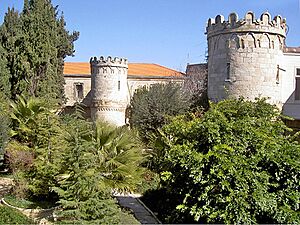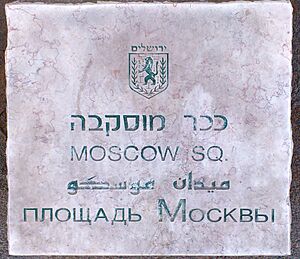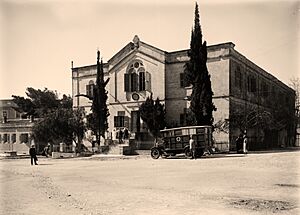Russian Compound facts for kids
The Russian Compound is a historic area in central Jerusalem. It has a large Russian Orthodox church, the Russian-owned Sergei's Courtyard, and the Russian Consulate General in Jerusalem. It also used to have places for pilgrims to stay. Today, some of these buildings are used by the Israeli government, like the Moscovia Detention Centre. One building is now the Museum of Underground Prisoners.
The compound was built between 1860 and 1890. An extra building, the Nikolai Pilgrims Hospice, was added in 1903. It was one of the first big areas built outside the Old City of Jerusalem. The main campus of the Bezalel Academy of Arts and Design is right next to the compound.
The Russian Compound covers about 68 dunams (17 acres). It is located between Jaffa Road, Shivtei Israel Street, and the Street of the Prophets. After 1890, it was surrounded by a gated wall, which is why it's called a "compound." However, it has been a freely open area in the city center for a long time. In October 2008, the Israeli government agreed to give ownership of Sergei's Courtyard back to the Russian government.
Contents
Exploring the Compound's Past
This area was once a parade ground for Turkish cavalry during the Ottoman Empire. It was first called "New Jerusalem." The Russian Compound is full of history, interesting sights, and unique features. For a long time, the hill where the compound stands was a key spot for armies trying to take over Jerusalem. For example, in 700 BC, the Assyrian army used it, and in 70 AD, Roman troops led by Titus gathered there.
The compound was built from 1860 to 1864. The Imperial Orthodox Palestine Society started the project to help the many Russian pilgrims visiting Jerusalem. A Russian architect named Martin Ivanovich Eppinger designed it. The compound included a mission (called Dukhovnia), a consulate, a hospital, and places for pilgrims to stay.
Later, the compound became a main center for the British Mandate government. The women's hostel was used as the main prison. Today, it is a museum about members of groups like the Irgun and Lehi who were held there.
In the 1960s, the Israeli Administrator General Haim Kadmon bought most of the Russian Compound. The only parts not bought were the Church of the Holy Trinity and the Sergei Courtyard. For many years, the complex was a lively spot in Jerusalem. Recently, the city has been planning to make it a residential area. The city's main offices at Safra Square are on the edge of the compound, and other government offices are also in the area.
Russian Pilgrims and Early Buildings
After people in Russia became Christians, they started making journeys to the Holy Land. By the 1800s, thousands of pilgrims came to the Holy Land, which was ruled by the Ottomans. Many came for Easter. The Russian Orthodox Church sent more pilgrims than any other group. Some even walked all the way from Russia!
The Russian Compound began to grow in the early 1800s. The first hospital for pilgrims outside the Old City walls opened there. It also had a market where local sellers could offer goods and services to the pilgrims. In 1847, the first Russian Church Mission came to Jerusalem. In 1857, it was officially recognized by the Sultan of Turkey. Its goal was to guide Russian pilgrims and help Orthodox Arab people in Palestine and Syria.
In 1858, the entire area of the Compound was sold to the Russian Empire. The Russian government and church, led by Czar Alexander II, were worried about the Russian pilgrims. They built many hostels, monasteries, and churches, including the large Russian Compound. This compound was one of the most impressive sites outside the city walls. It was chosen because it was close to the Old City and the Church of the Holy Sepulcher. It covers 68,000 square meters (about 17 acres).
Between 1860 and 1864, several buildings were constructed. The Marianskaya Women's Hospice was built in the northeast, and the Russian consulate in the southeast. A hospital was built to the southwest. A separate building housed the Russian Orthodox religious mission and rooms for priests and wealthy pilgrims. To the northwest was the large Elizabeth Men's Hospice, which could hold many people. Sometimes, tents were needed for the huge crowds of pilgrims. Finally, the Holy Trinity Cathedral was built in 1872 as the main church of the Compound.
The Imperial Orthodox Palestine Society, based in St. Petersburg, supported this huge project. Russian architect Martin Ivanovich Eppinger designed the buildings, inspired by Byzantine architecture. All the building materials and furniture came from Russia on ships specially made for this purpose. These ships also brought many pilgrims. The large courtyards had stables, chicken coops, wells, and a laundry.
In 1889, the Sergei Imperial Hospice was finished. It was built by George Franghia, a local engineer. This building offered 25 fancy rooms for "rich and honorable guests." It was on a 9-acre (36,000 m2) plot of land next to the main compound. Grand Duke Sergei, brother of Czar Alexander III, asked for it to be built. Newspapers called the beautiful stone building "one of the most marvellous buildings in the city."
World War I changed everything. All Russian priests and staff were sent away from Palestine. All the churches were closed. Turkish soldiers took over the Russian Compound. After the October Revolution and the rise of communist rule in the Soviet Union, very few Russian pilgrims came to Jerusalem. The revolution also stopped the money needed to keep the Compound running. Most of the buildings were rented to the British authorities.
The British Mandate Period
In 1917, near the end of World War I, the British took over Palestine from the Ottomans. They ruled under an international mandate until 1948. The first British High Commissioner, Herbert Samuel, governed from 1920 to 1925. The British created a long park zone from the Russian Compound towards the Old City and Mount Scopus. Several other High Commissioners served until the British Mandate ended in 1948.

The compound became a main base for the British Mandate in Jerusalem. It was a center for government work. Local people, mostly Jews, were told to leave their shops and offices. The Russian buildings were turned into government offices. They housed police headquarters, courthouses, and the Immigration Office.
The women's hospice became Jerusalem's central prison. This happened as Jewish underground groups like the Haganah, the Palmach, the Lehi, and the Irgun became more active, leading to many of their members being arrested. Members of these groups were held here alongside Arab and Jewish criminals. They were later moved to the main prison in Acre.
In 1931, the British asked the chief rabbi to appoint a chaplain for the prisoners. Rabbi Aryeh Levine became known as the "Rabbi of the Prisoners." Every Shabbat, he walked from his home to the Russian Compound to lead services and spend time with the prisoners. He was called the "tzaddik" (a very righteous person) of Jerusalem. In 1965, "Rav Aryeh" was honored at a ceremony held in the old central prison courtyard.
After World War II, the British army started building 'security zones' in the three largest cities. In Jerusalem, four such zones were created. The main one was in the Russian Compound. The whole area was blocked off with barbed wire fences, and people could only enter with an identity card. Jewish underground groups called it "Bevingrad," after Ernest Bevin, the British foreign minister who was against Zionism.
As British control in Palestine weakened, stricter rules were put in place. The British decided to start executing Jewish underground prisoners. In 1947, two prisoners, Meir Feinstein and Moshe Barazani, used a hand grenade to end their lives the night before their planned execution. The grenade had been secretly brought into their cell inside an orange.
Right after the last British soldiers left Jerusalem in 1948, Irgun fighters took over the empty Generali building. After raising their flag, they moved towards the Russian Compound, where the British intelligence (CID) had been. Some Irgun members had been held in the central prison there and felt a special satisfaction returning as victors.
On May 15, 1948, during the 1948 Palestine war, the Haganah, with help from the Etzel and Lehi, captured the compound. This operation was called Operation Kilshon.
The Russian Compound in Israel
In 1948, after the Soviet Union recognized the state of Israel, Israel returned all Russian church properties in its territory to the Moscow Patriarch. This included the Russian Compound. In 1964, the Israeli government bought most of the property, except for the cathedral and one other building. The payment was made with $3.5 million worth of oranges, because Israel did not have much foreign money at the time. The Jerusalem municipality building and the nearby Safra Public Square were built here.
Today, the compound is still used for various purposes. It houses an Israeli lock-up, and families of prisoners can often be seen outside. The Ministry of Agriculture, courts, and Jerusalem's police headquarters are in other buildings.
For many years, the Russian Compound was a lively area in Jerusalem. The city has recently been planning to redevelop it as a new business and culture district. Plans include a circular plaza around the cathedral, a shopping center, and renovating the historic buildings.
The creation of a new campus for the Bezalel Academy of Arts and Design, which opened in 2023, was a key part of this renewal. In 2006, an international competition was held for the design of the new campus. It was hoped that the campus would help students connect with the city center and bring a student population to the area.
In October 2008, the Israeli government agreed to give Sergei's Courtyard back to Russia. This building had originally been part of the Russian compound and had housed offices for Israel's Agriculture Ministry and the Society for the Protection of Nature in Israel. These government offices moved out in March 2011.
In 2023, the Bezalel Academy of Arts and Design moved most of its 3,000+ staff and students to a new building next to the compound.
Important Buildings in the Compound
Holy Trinity Cathedral
The Holy Trinity Cathedral is the main church of the Russian Compound. It was built with money donated by people from the Russian Empire. Construction started in 1860, and the church was officially opened in 1872. The inside of the main hall, dome, and two aisles are painted blue with pink details and show many pictures of saints. The church has four bell towers. It is known as one of Jerusalem's most unique churches.
Sergei Courtyard
The Sergei Courtyard is at the corner of Heleni HaMalka and Monbaz Street. It has a courtyard and a tower in the Renaissance style. It is named after Grand Prince Sergei, who was the brother of Tsar Alexander III. He was also the President of the Russian Orthodox Palestine Society. Architect George Franghia finished it in 1889. It was built as the "Sergei Imperial Hospice" for pilgrims from the Russian nobility. It covered 9 acres (36,000 m2) and was made entirely of cut stone. Its 25 luxurious rooms were for wealthy visitors. Newspapers called it "one of the most marvellous buildings in the city." A local bank, Jacob Valero and Company, helped pay for its construction.
During the British Mandate, the building was taken over by the government and used for public works and a passport office. After Israel was formed, the Israeli government used it. Until 2008, it housed offices for the Agriculture Ministry and the Society for the Preservation of Israel Heritage Sites. In 2008, the Israeli government gave the Sergei Courtyard back to the Russian government.
Duhovnia (Russian Mission Building)
This long building is south of the cathedral, towards the new city hall. It was built in 1863 as a hospice. It also held the offices of the Russian patriarchate's church mission, called Duhovnia. It has a courtyard with a church (St Alexandra) in the middle. This building housed all of Jerusalem's courts, including the Israeli Supreme Court, until 1992. Now, it is only used for lower courts. The Russian Mission used to use the building and still has an office there, but its main center is now on the Mount of Olives.
Southern Gate
The Southern Gate is between the mission building and the hospital on Safra Square. It was built in 1890 as part of the wall around the Russian Compound. It was moved about 50 meters (164 feet) south of its original spot when Safra Square and the new City Hall were built.
Hospital
This building is located at 13 Safra Square.
Russian Consulate
The Russian Consulate is on Shivtei Yisraʾel Street, behind the municipality complex. It was built in stages starting in 1860. It mixes European styles with local building methods. From 1953 to 1973, it housed the school of pharmacy and later laboratories for the Hebrew University.
Elisabeth Courtyard (Men's Hospice)
This building was constructed in 1864 as a hostel for about 300 male pilgrims. It is on Monbaz Street today. Above its entrance, there is an inscription that says "Elisabeth Courtyard" and the symbol of the Imperial Russian Orthodox Palestine Society. This building now serves as the police headquarters.
Northern Gate
The Northern Gate is across from the Sergei Building. The compound used to have a wall around it with two main gates, one in the north and one in the south, built in 1890. Only one of the two northern gatehouses is still standing. The other was taken down in the 1970s. The symbol of the Imperial Russian Orthodox Palestine Society is on its front.
Marianskaya Courtyard (Women's Hospice)
This hostel for Russian women pilgrims is at 1 Misheol Hagvurah Street. It was built in 1864 in the Neoclassical style. On the front of the building, there is a Russian inscription that means "Marianskaya women's hospice" and the symbol of the Imperial Russian Orthodox Palestine Society above the entrance. With its long hallways and separate rooms, it was perfect for a hostel or, later, a prison, as the British used it during their rule in Palestine.
During the British rule, many prisoners, both regular criminals and political prisoners, were held here. Jews and Arabs were kept together. While the facility held many prisoners from Jewish underground groups, those sentenced to death were sent to Acre prison for executions. The British did not use the gallows in this Jerusalem prison for Jewish prisoners, fearing strong reactions. Prisoners from Jewish underground groups were sometimes made to build coffins and gravestones for the British police and soldiers they had fought against. The guards would tell them, "What you start on the outside, you finish on the inside." The building now houses the Underground Prisoners Museum. The barbed wire fence, bars, and the words "Central Prison Jerusalem" on the door are from the British Mandate period.
Nikolai Courtyard – Pilgrims Hospice
In 1903, another hospice for Russian pilgrims was built. It was called the Nikolai Pilgrims Hospice, named after Tsar Nicholas II. It was large enough to hold 1,200 guests. During the British Mandate, part of it was used as a police headquarters and government offices. Later, it was the British intelligence headquarters. It was bombed twice by the Jewish underground organization Irgun in 1945.
Ancient Discoveries
The "Finger of Og" Column
In front of the police headquarters on Shneor Cheshin Street, there is a huge stone column. It dates back to either the Second Temple or the Byzantine period. This column was found in 1871. Long ago, there was a quarry here, a place where stone was dug out. This column, which is 12 meters (39 feet) long, broke while it was being cut and was left in the rock. It was probably meant for the Herodian Temple or a building from the Theodosian period (late 300s AD). People often call it the "Finger of Og," after a giant king from the Bible.
Jerusalem's Ancient Third Wall
Recent archaeological digs suggest that Jerusalem's ancient "Third Wall," built by Agrippa I, reached as far as the Russian Compound. A newly found section of a wall, about 6.2 feet (1.9 meters) wide, was covered with large ballista stones (stones used as projectiles from a type of crossbow) and sling stones. Pottery found there also shows that this battlefield dates back to Roman times. The remains of a watchtower along the wall were also discovered.
A Mysterious Ancient Burial Site
Another excavation found a sealed water cistern (an underground tank for collecting water). It contained the remains of at least 124 people, including men, women, children, and even unborn babies. Based on the pottery and layers of earth, this burial dates to the late 2nd or early 1st century BCE, during the time of the Hasmonean king Alexander Jannaeus. These findings might be archaeological proof of political violence in Hasmonean Jerusalem, possibly linked to the Judean Civil War, which is described by Josephus and in the Dead Sea Scrolls.
See also
 In Spanish: Complejo Ruso de Jerusalén para niños
In Spanish: Complejo Ruso de Jerusalén para niños
- Russian Orthodox Church Outside Russia
- Church of Mary Magdalene
- Russians in Israel
- Moscovia Detention Centre













